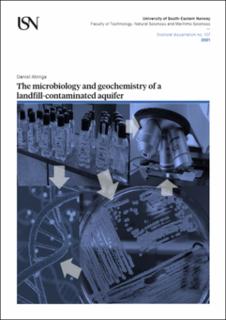| dc.contributor.author | Abiriga, Daniel | |
| dc.date.accessioned | 2021-11-02T10:13:47Z | |
| dc.date.available | 2021-11-02T10:13:47Z | |
| dc.date.issued | 2021-10-20 | |
| dc.identifier.isbn | 978-82-7206-627-6 | |
| dc.identifier.issn | 2535-5252 | |
| dc.identifier.uri | https://hdl.handle.net/11250/2827236 | |
| dc.description.abstract | Thousands of aquifers worldwide have been polluted by landfill leachates and many more remain threatened. However, the ecology of these perturbed aquifers remained understudied. The current study incorporates aspects of both the microbiology and geochemistry of a leachate-receiving aquifer. The microbiological component includes comparing the results of different microbiological techniques; assessing the effect of season, water chemistry, distance, and time on the composition of the aquifer microbial communities; determining the overall microbial assembly and co-occurrence network; and comparison of planktonic and sediment-attached microbial communities. The groundwater geochemistry was used to evaluate the significance of the natural attenuation processes in the landfill-aquifer system.
Comparisons of results from culture-based approach, direct fluorescence microscopy, and 16S rRNA metabarcoding show a good concordance. Results from variation partitioning analyses show that the microbial community composition of the groundwater was influenced by the groundwater geochemistry, distance, season, and time, although both season and time seems to have played a minor role. The microbial co-occurrence network analysis results indicate that the microbial communities in the aquifer assemble deterministically. A key contributor to the deterministic assembly is the landfill leachate, which caused an ecological gradient to develop along the groundwater flow path as reflected by the groundwater geochemistry. Comparison of the microbiota of groundwater and sediment indicate a strong difference in the microbial community composition between the groundwater and the sediment. While the planktonic communities were dominated by Proteobacteria, the sediment-attached communities were enriched in Acidobacteria. Thus, for a more complete characterisation of an aquifer microbiome, it is important to sample both groundwater and aquifer sediment.
These findings shed light into the microbiology of an understudied ecosystem and has clearly demonstrated that the operation of the landfill has altered the microbial composition of the aquifer. The long-term analysis of the groundwater geochemistry suggests that the landfill has attained its stabilised stage, as indicated by the tailing-off of contaminants, which hints on the possibility of the aquifer recovery. This underscores the significance of non-invasive natural attenuations and has significant consequences for future pollution intervention strategies. This thesis provides a good resource to researchers and environmental practitioners both in the government and private sectors, particularly for strategic planning, designing, implementation and management of site remediation. It is of interest to microbiologists, microbial ecologists, geochemists, hydrogeologists, and environmental scientists. | en_US |
| dc.language.iso | eng | en_US |
| dc.publisher | University of South-Eastern Norway | en_US |
| dc.relation.ispartofseries | Doctoral dissertations at the University of South-Eastern Norway;107 | |
| dc.relation.haspart | Article 1: Abiriga, D., Jenkins, A., Alfsnes, K., Vestgarden, L.S. & Klempe, H.: Characterisation of the bacterial microbiota of a landfill-contaminated confined aquifer undergoing intrinsic remediation. Science of the Total Environment 785, (2021), 147349. https://doi.org/10.1016/j.scitotenv.2021.147349 | en_US |
| dc.relation.haspart | Article 2: Abiriga, D., Jenkins, A., Alfsnes, K., Vestgarden, L.S. & Klempe, H.: Spatiotemporal and seasonal dynamics in the microbial communities of a landfill-leachate contaminated aquifer. FEMS Microbiology Ecology 97(7), (2021), fiab086. https://doi.org/10.1093/femsec/fiab086 | en_US |
| dc.relation.haspart | Article 3: Abiriga, D., Jenkins, A., Alfsnes, K. & Klempe, H.: Microbial deterministic assembly and co-occurrence network in an aquifer under press perturbation. Manuscript submitted to Frontiers in Microbiology | en_US |
| dc.relation.haspart | Article 4: Jenkins, A., Abiriga, D., Alfsnes, K., Vestgarden, L.S. & Klempe, H.: A comparison of sediment and groundwater microbiomes in a landfill leachate-contaminated aquifer undergoing intrinsic remediation. Manuscript | en_US |
| dc.relation.haspart | Article 5: Abiriga, D., Jenkins, A., Vestgarden, L.S. & Klempe, H.: A nature-based solution to a landfill-leachate contamination of a confined aquifer. Manuscript under second review in Scientific Reports. The published version is available at https://doi.org/10.1038/s41598-021-94041-7 | en_US |
| dc.rights.uri | http://creativecommons.org/licenses/by-nc-sa/4.0/deed.no | |
| dc.subject | microbial ecology | en_US |
| dc.subject | groundwater microbiology | en_US |
| dc.subject | aquifer sediment microbiology | en_US |
| dc.subject | groundwater chemistry | en_US |
| dc.subject | natural attenuation | en_US |
| dc.title | The microbiology and geochemistry of a landfill-contaminated aquifer | en_US |
| dc.type | Doctoral thesis | en_US |
| dc.description.version | publishedVersion | en_US |
| dc.rights.holder | © The Author, except otherwise stated | en_US |
| dc.subject.nsi | VDP::Matematikk og Naturvitenskap: 400::Geofag: 450::Hydrogeologi: 467 | en_US |
| dc.subject.nsi | VDP::Matematikk og Naturvitenskap: 400::Basale biofag: 470::Generell mikrobiologi: 472 | |

